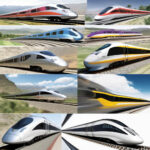China Repurposes US Cold War Hypersonic Engine for Unprecedented Speeds
A Chinese state-funded research team used conventional jet fuel to test a hypersonic propulsion system that could potentially propel aircraft at speeds 16 times faster than the speed of sound. This breakthrough development signals China’s continued advancement in aerospace technology and its potential to revolutionize air travel in the near future.
The hypersonic engine, initially developed by the United States during the Cold War era, has been reengineered by Chinese researchers to operate efficiently using traditional jet fuel. This adaptation not only demonstrates China’s engineering capabilities but also highlights the country’s strategic vision in repurposing existing technologies for modern applications.
By harnessing the power of hypersonic propulsion, aircraft could travel at incredible speeds, reducing travel time between destinations significantly. For example, a flight from Beijing to New York, which currently takes approximately 14 hours, could be completed in just 45 minutes with this new technology. Such a leap in speed could transform the aviation industry, making long-distance travel more accessible and time-efficient than ever before.
Moreover, the successful testing of this hypersonic engine showcases China’s commitment to innovation and scientific progress. By investing in cutting-edge research and development, the country is positioning itself as a global leader in aerospace technology, challenging traditional powerhouses like the United States and Russia.
In addition to its implications for commercial air travel, the hypersonic engine could also have significant military applications. The ability to deploy aircraft at such high speeds could revolutionize aerial warfare, providing China with a strategic advantage in defense capabilities.
However, with great technological advancements come concerns about safety and regulation. The unprecedented speeds at which these aircraft would travel raise questions about air traffic control, infrastructure readiness, and potential environmental impact. Addressing these challenges will be crucial in the successful integration of hypersonic propulsion systems into our skies.
As China continues to push the boundaries of aerospace innovation, other countries are also ramping up their efforts to develop hypersonic technologies. The race to achieve hypersonic flight capabilities is intensifying, with implications not only for transportation and defense but also for space exploration and scientific research.
In conclusion, China’s successful reengineering of the US Cold War hypersonic engine represents a significant milestone in the field of aerospace technology. The potential for aircraft to travel at speeds 16 times faster than the speed of sound opens up a new era of possibilities for air travel and defense. As we look towards the future, it is clear that the age of hypersonic flight is fast approaching, with China at the forefront of this groundbreaking innovation.
China, Hypersonic Engine, Aerospace Technology, Air Travel, Innovation.












